Product Images Gabapentin
View Photos of Packaging, Labels & Appearance
- Formula - gabapentin fig1
- gabapentin fig10
- gabapentin fig11
- Figure 1 - gabapentin fig2
- Figure 2 - gabapentin fig3
- Figure 3 - gabapentin fig4
- Figure 4. Responder Rate in Patients Receiving Gabapentin Expressed as a Difference from Placebo by Dose and Study: Adjunctive Therapy Studies in Patients ≥12 Years of Age with Partial Seizures - gabapentin fig5
- PACKAGE LABEL-PRINCIPAL DISPLAY PANEL - 100 mg (100 Capsules Bottle) - gabapentin fig6
- PACKAGE LABEL-PRINCIPAL DISPLAY PANEL - 300 mg (100 Capsules Bottle) - gabapentin fig7
- PACKAGE LABEL-PRINCIPAL DISPLAY PANEL - 400 mg (100 Capsules Bottle) - gabapentin fig8
- gabapentin fig9
- Chemical Structure - gabapentin str
Product Label Images
The following 12 images provide visual information about the product associated with Gabapentin NDC 65862-199 by Aurobindo Pharma Limited, such as packaging, labeling, and the appearance of the drug itself. This resource could be helpful for medical professionals, pharmacists, and patients seeking to verify medication information and ensure they have the correct product.
Formula - gabapentin fig1
This text appears to be referencing a formula for calculating something called "Lt". It involves multiplying the age (in years) by the weight (in kilograms) and then perhaps dividing by something else represented by "creatinine (g- 085 for female patents)". It is not clear what purpose this equation serves or what it is intended to calculate.*
gabapentin fig10
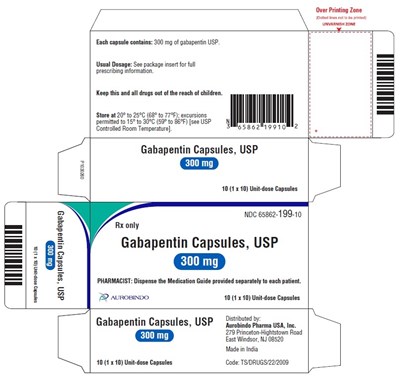
This is a description of medication in the form of Gabapentin Capsules, USP. The medication is intended for oral consumption and contains 300mg of gabapentin USP. The package insert should be consulted for information about the typical dose. The temperature range for storage is between 15-30°C (59-86°F) and the medication should be kept out of reach of children. The listing includes an NDC code and the name of the distributor, which is Nugbinio Pharma Inc. There is no other available information in the text.*
gabapentin fig11
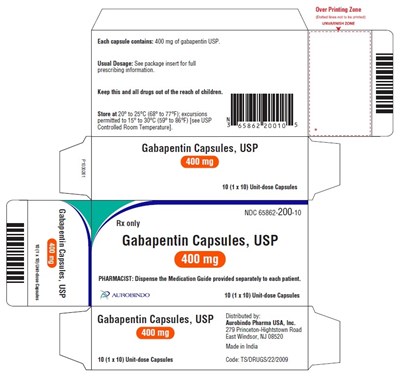
Gabapentin Capsules, USP are a medication that contains 400 mg of gabapentin USP in each capsule. The usual dosage instructions can be found in the package insert. It is important to keep this and all drugs out of the reach of children and to store them at a temperature between 20° and 25°C. These capsules come in unit-dose packaging and are labeled with the code TSIDRUGS22/2009. Pharmacists should dispense a medication guide separately to each patient. The manufacturer is Aurbindo and they are located in East Windsor, 1 08520, India.*
Figure 1 - gabapentin fig2
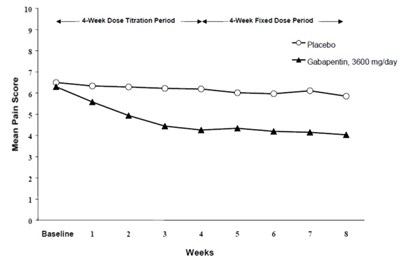
The text appears to be a chart with a title "Mean Pain Score" and data related to a study with two different periods - "Titration Period" and "Fixed Dose Period" - and treatments being compared (placebo and Gabapentin at a dosage of 3600 mg/day). The chart shows pain scores over the course of seven weeks. Therefore, it cannot be described in text format only.*
Figure 2 - gabapentin fig3
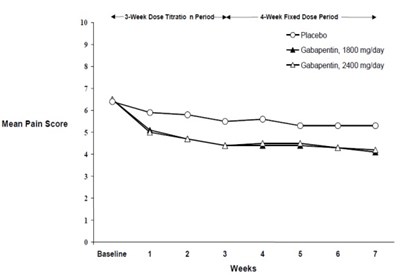
The text describes a chart or graph that displays the mean pain score for a study with different doses of Gabapentin over a 4-week fixed dose period. The doses compared are a placebo, 1800 mg/day, and 2400 mg/day. There is also a mention of a baseline measurement.*
Figure 3 - gabapentin fig4
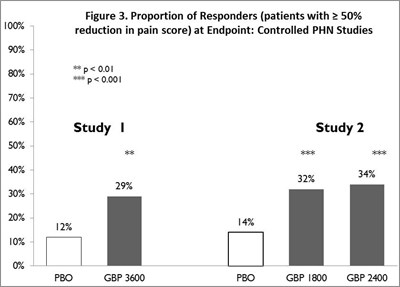
The text is showing statistical data related to pain reduction in controlled PHN studies. It includes a figure showing the proportion of responders with a pain score reduction of at least 50%, and also percentages obtained from two studies with different treatments. It also shows some symbols and numbers related to statistical significance of the results.*
Figure 4. Responder Rate in Patients Receiving Gabapentin Expressed as a Difference from Placebo by Dose and Study: Adjunctive Therapy Studies in Patients ≥12 Years of Age with Partial Seizures - gabapentin fig5
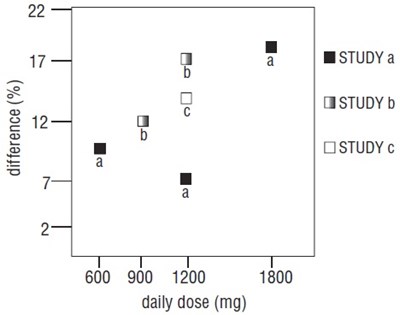
PACKAGE LABEL-PRINCIPAL DISPLAY PANEL - 100 mg (100 Capsules Bottle) - gabapentin fig6
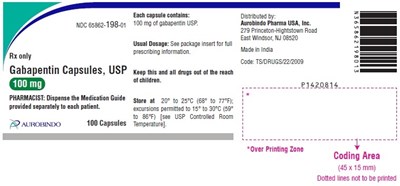
Gabapentin Capsules, USP containing 100mg of gabapentin USP are available as 100 capsules manufactured by Aurobindo. The medication guide should be provided separately to each patient by the pharmacist. The usual dosage information may be found in the package insert. The drug must be kept out of reach of children and stored at 20 to 25 degrees Celsius (68 to 77 degrees Fahrenheit) with excursions permitted to 15 to 30 degrees Celsius (59 to 86 degrees Fahrenheit) as specified in the USP Controlled Room Temperature guidelines. The product was distributed by Aurobindo Pharma USA, Inc., at 273 Princeton-Hightstown Road in East Windsor, NJ, and was manufactured in India under code TSDRUES22/2009. The remaining text is not relevant.*
PACKAGE LABEL-PRINCIPAL DISPLAY PANEL - 300 mg (100 Capsules Bottle) - gabapentin fig7
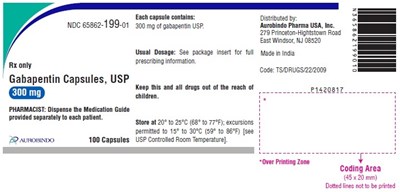
Gabapentin Capsules, USP with 300mg of gabapentin USP content are available in 100 capsules manufactured by Aurobindo Pharma USA, Inc. It is a prescription-only drug that should be dispensed with an individual medication guide to every patient by the pharmacist. The insert package has complete prescribing information, and the medicine should be kept out of children's reach. The drug should be stored between 20°C to 25°C (66°F to 77°F) with excursions permitted to 15°C to 30°C (59°F to 86°F). The distribution is from East Windsor, NJ 08520, and the manufacturer country is India. However, the overprinting zone in the coding area must be excluded from printing.*
gabapentin fig9
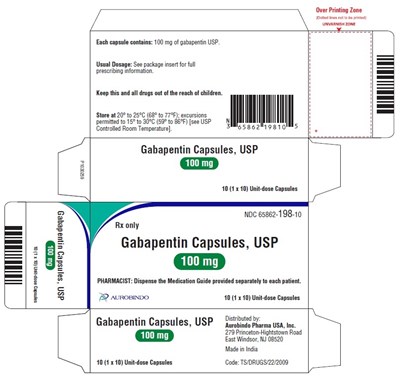
Gabapentin Capsules, USP containing 100 mg of gabapentin USP are available in a 10 (1 x 10) unit-dose capsules pack distributed by Aurobindo Pharma USA, Inc. The recommended storage temperature is 20° to 25°C (68° to 77°F), with excursions permitted to 15° to 30° (50° to 86°F) according to USP controlled room temperature standards. The usual dosage information is provided in the package insert, and it is advised to keep this and all drugs out of the reach of children.*
* The product label images have been analyzed using a combination of traditional computing and machine learning techniques. It should be noted that the descriptions provided may not be entirely accurate as they are experimental in nature. Use the information in this page at your own discretion and risk.

